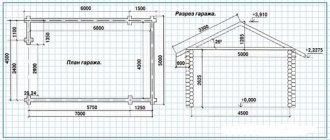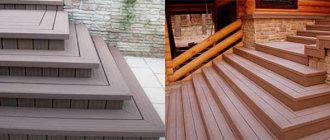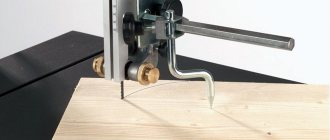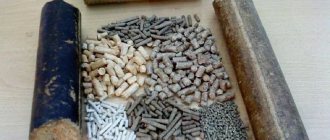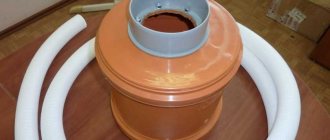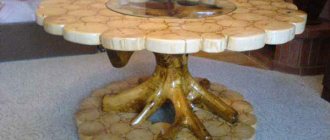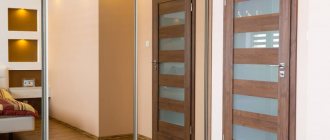Today, site fencing is made from a variety of materials; an original version can be obtained by using a slab. We are talking about the material obtained by sawing logs. One side is smooth, and the other is untreated, covered with bark and knots, which allows it to maintain maximum naturalness. The slab fence is again gaining popularity among owners of private houses.
Pros and cons of a slab fence
Fencing made of such material has both advantages and disadvantages. The first include:
- Low cost
. Croaker is considered a production waste, so its price is very low. - Ecological cleanliness
. The obapole fence is made of natural wood - a natural material that has a beneficial effect on human health. - Easy to install
. A slab fence does not require a foundation and there are no difficulties with installation, even with your own hands. - Reliability of the design
. It cannot be compared with a metal profile, but if you wish and have some skill, you can build a strong fence for your site. - Distinctive appearance
. A fence made from this material is chosen by those who want to embody an authentic rustic style in a truly Russian spirit on their site.
There are also disadvantages to such a fence. These include:
- Large percentage of waste. Croakers can be found on sale in bulk or in packs. The second option is preferable, since the products have already been sorted, but even there there may be individual elements suitable only for lighting the stove.
- The need for additional wood processing to increase service life, which means extra money and time.
- All processing and installation work is in most cases done manually.
Features of the solution
A suburban area fence made of logs not only looks impregnable, but in fact is so. The main material for the work is natural or machined parts with a diameter of 10-15 cm. The length of the cylinders is selected in relation to the average height of the fence, which is 170-180 cm.
You can obtain parts for installing a fence in several ways:
- At logging sites, select small-diameter logs that are not in demand by loggers;
Purchase a rounded log of small diameter;
Fence logs in cassettes
- Smooth birch cylinders of small diameter can be purchased in unlimited quantities at plywood mills. They are formed when veneer is cut from a log. The maximum length of such rods usually does not exceed 160 cm.
A log fence can be of two main types:
the first of them involves vertical installation of parts; in the second, the cylinders are located horizontally.
Example of horizontally aligned cylinders
Each method has its own characteristics, which we will discuss below.
Vertical log fence
A palisade is a fence made of vertically placed logs. This is the most ancient version of the fence, which was used to protect ancient Slavic settlements. It not only made it possible to obtain a solid log wall, but also had an additional protective element - the sharp ends of the parts.
Palisade - ancient fortress wall
To make such a fence with your own hands, proceed as follows:
- Prepare the required amount of material for work. Calculating the number of logs is not difficult - you just need to divide the total length of the fence by the average diameter of the rods. So, to fencing an area of 15x20 meters, the number of rods with a diameter of 10 cm will be determined by the formula: (15+20)*2:0.1=700.
- The next stage is preparing the installation site.
It can be done in the following ways:
- driving in stakes pointed at the bottom;
- digging rods into a previously prepared trench;
- combined method.
Depending on the chosen option, stretch a strong cord around the perimeter of the site, remove the turf along it and dig a ditch, the depth of which should be at least 0.6 meters, the width of the bayonet of a shovel. Next, we begin preparing the logs.
- To protect the underground part of the wooden parts of the fence, our ancestors burned them over fires. The resulting coal reliably protected the wood from rotting, damage by fungi and insects and allowed the fence to stand for several decades. Of course, this method is still possible today, but there is a simpler and faster solution.
We are talking about bitumen mastics that have a viscous consistency and are completely ready for use.
It is only necessary to thoroughly cover the lower parts of the logs with bitumen to a length of 60 cm and let it dry. After this, you can proceed to the next stage of work.
- When installing a fence, install the logs in the ditch with the treated parts down as close to each other as possible. Over time, due to the evaporation of moisture from the wood, the density of the material increases, but its diameter may decrease slightly, which will lead to the formation of cracks in the fence. To avoid this, it is better to use pre-dried parts.
Types of slab fence
There are the following types of obapola fencing:
- Vertical
. In this case, the lumber is installed perpendicular to the surface of the earth. - Horizontal
. For such a slab fence, the boards are located along the surface of the ground. - Two-way
. The lumber is fastened in a checkerboard pattern. - Various decorative types
. A fence made of burnt slab, which looks colorful and interesting, has become very popular.
Vertical slab fence
In appearance, such fences for a private house made of slab are similar to a classic picket fence. First, racks are installed along the entire perimeter of the site, and then two boards are nailed to them in a horizontal position - on top and bottom. This is the basis of the future fence, on which the slab is installed, doing it vertically. Some people prefer to fasten the lumber with a gap, while others prefer the option with the boards tightly arranged. In any case, the fence should not be completely blank. It is necessary to provide ventilation under the fence to bring fresh air into the area.
Horizontal slab fence
As a rule, this option for attaching boards can be seen as a fence in pastures. This structure cannot be called a full-fledged fence, because you can easily crawl through it and even inside it and get inside. However, if you mount the boards closely, you can get a reliable and high-quality fence. This type of wooden slab fence is simpler and easier to install. The material is attached directly to the posts. There is less waste, as with the vertical type; pieces of very different lengths are used here.
Double-sided slab fence
This is a type of horizontal fencing. It requires twice as much material and additional racks. The result is a stylish slab fence, which is also completely blind and does not allow you to see what is happening on the site. Even floors with uneven edges can be carefully arranged together, painted in a beautiful color, and decorated with baskets of artificial flowers. If you cover the upper part of the slab fence with a metal canopy, you can significantly extend its service life.
Barn
Utility rooms for storing shovels, rakes, watering cans and other garden utensils are small in size and have minimal design requirements. They are erected without a foundation on several supports made of rolled metal or wooden beams.
In most cases, it is enough to assemble a frame of 2.5 x 1.5 meters, erect walls up to 2 meters in height and equip a pitched roof. Sanded slabs are used for the walls. The boards are attached to the support with an overlap, this allows you to avoid gaps and hide the screw heads. It is also used for the roof frame.
Original slab fence
Even from such illiquid, waste material you can create a real masterpiece, a whole work of art. A decorative fence made of slab will decorate the site, its highlight. Here are the popular options:
- A fence made of treated, varnished lumber, decorated with all kinds of figures and other additional elements.
- A fence containing separate sections, each of which in itself is a reflection of the owner’s non-standard imagination. Here the boards are laid at an angle, vertically, horizontally and even combined with straw weaving.
- A fence with jagged edges resembling the outlines of wave crests.
Wicker fence made of slab
Another original variety that attracts many owners of suburban areas. A wicker fence made of slabs is mounted according to the same principle by which in Rus' baskets were made from wicker, straw and other available materials. To do this, you also first need to install vertical posts, and only then stretch the logs on both sides of them, acting in a checkerboard pattern. This is a labor-intensive process that requires pre-treatment of the wood. But the result is simply amazing and is suitable for fencing even modern country houses.
Briefly about the main thing
Croaker is one of the most accessible and inexpensive materials for fencing. If you know how to choose it, you can find the ideal compromise between price and quality, spending a minimum of money and time on a temporary fence or getting a very reliable, beautiful and unusual fence for a suburban area. With imagination and skillful hands, slabs from waste material are transformed into exclusive designs to the envy and surprise of your neighbors.
Question
Write in the comments if you have a fence, barn or any other building finished with slab? If you want to show off the beautiful finish, attach a photo.
Which croaker should I take for the fence?
When choosing these scrap lumber, you can be disappointed if you don't know what criteria to adhere to. Experts recommend paying attention to:
- Type of croaker
. It can be wood-burning and business-like. The first one is only suitable for lighting a stove, because it has many defects, different parameters and substandard appearance. A fence made from industrial slab turns out to be neat, even and beautiful, because such material is pre-sorted and stacked in piles of the same length and width. - Presence of bark
. Some people specifically choose a material with an outer layer as decoration, but it must be remembered that it requires additional processing from bark beetles. - Wood species
. There are no special requirements here, but experts do not recommend choosing poplar and birch. In the first case, the slab fence will begin to quickly rot, and in the second, it will deform over time. - The width is both half
. The optimal dimensions are 20–25 cm. If they are larger, then cracks may appear. - Evenness of edges
. This is important for those who install a solid fence.
Ways to decorate a slab
A croaker that has been sanded and soaked in antiseptic will still darken over time. If this is not a problem for the fence along the garden, then the outer part, from the side of the street and the yard, would like to be decorated somehow.
Here are some options:
- Wood primer, plus two coats of acrylic exterior paint. With the addition of color, you can paint the fence any color.
- Treatment with stain followed by varnishing. If you use varnish for exterior work, you won’t have to correct it every year, and such a fence will look noble and stylish.
- Partial firing of wood followed by varnishing. You can work with a blowtorch. Surely no one will have such a fence.
If you are not afraid of difficulties and are ready to mix different substances, you can make Swedish paint. It performs several functions: decorates the wooden surface, protects the wood from rotting and various beetles.
To prepare the composition you will need:
- 500 g of flour of any kind;
- 250 g each of table salt and copper sulfate;
- 240 g of red lead (sold in online stores);
- 230 ml drying oil;
- 3 liters of water.
Flour is combined with water and a paste is boiled, as for gluing wallpaper or creating art. The hot paste is filtered through a fine metal sieve, put back on the fire and vitriol, drying oil and salt are added. Mix thoroughly, achieving a homogeneous mass and, without removing from the heat, add 1.5 liters of water. The resulting composition is used to treat the croaker.
Depending on the quality of the wood, the consumption will be at the level of 200-250 g/m2 of area.
Slab fence posts
They can be made from a variety of materials:
- The easiest option is to use the same wide and thick slab, cutting it lengthwise.
- Some combine several fundamentally different materials with each other, for example, the supports are made of brick, and the fence is made of wood. This type of slab fencing no longer looks “cheap”. This is a stylish and original design, solid and not without a touch of antiquity.
- The pillars are made of stone - natural or artificial.
Woodshed and square
To protect firewood from rain and snow in your summer cottage, you can’t do without a woodcutter. This building, as a rule, is located in the outskirts, so there is no point in spending money on expensive materials.
The basis of the frame is formed by wooden beams or logs dug into the ground. The supports are connected with boards cut to length in advance. To ensure greater rigidity, a pair of diagonal braces can be placed along each wall. They will not allow the woodshed to spread out. The roof is also covered with a slab, located with a rounded surface inward. A sheet of roofing material or ondulin is laid on top.
A similar technology is used to create a square. A capacious box is constructed from the slab, which will prevent the coal from crumbling during storage.
The only difference between a square and a wood burner is a narrower pitch between the boards. To avoid wide gaps, you will have to pre-sort the material suitable for its geometry.
DIY slab fence
Having purchased timber, prepared poles and other consumables - antiseptic, nails, cement, sand, crushed stone, bitumen mastic or resin, you can make a slab fence for your dacha with your own hands. In addition, you will need the appropriate tool. Here's how to make a beautiful slab fence:
- Lay out the route of the future fence.
- Mark places for installing poles. As a rule, they are located every 2.5 m.
- Drill holes 1 m deep in the designated locations.
- Root the wood, that is, remove the bark from it.
- Install the pillars using one of the selected methods - concreting, driving into wells or installation with backfilling. If the supports are made of wood, then the last two options are more often used.
- When the concrete has hardened, install joists - crossbars, nailing them to the posts.
- Pin the slab in an overlapping manner using the chosen method.
- If desired, fill the top with a canopy made of the same lumber.
Calculation of the length of the fence
Before purchasing timber and other auxiliary materials, it is necessary to calculate their quantity. To do this, you need to determine the total length of the fence using one of two methods:
- calculation of the fence according to the area of the site;
- determination of external dimensions based on land documents;
- full-scale measurements of the sides of the site.
The perimeter of a square plot can be easily calculated using the area
The first method is convenient only when you need to calculate the length of the fence on a square-shaped area with straight boundaries. You need to take the area value, take the square root of it and get the length of one side. All that remains is to multiply it by 4 and get the perimeter, this is the length of the fence. For other shapes, this technique is not suitable, since with the same area, the perimeter of a rectangular area is larger than a square one.
Example. A square plot with an area of 1000 m2 will have a length of one side of 31.6 m and a perimeter of 126.4 m. A rectangular plot with sides of 20x50 m has the same area, but the perimeter will be larger - 140 m.
A rectangular area of the same area has a larger perimeter
The second method is also convenient because it does not require time or labor. The documents contain a plan of the land plot, where all the required dimensions are indicated. But if there are no such documents or the calculation needs to be clarified, then the best method is to measure the area with a tape measure or laser range finder, then you definitely won’t go wrong when purchasing timber.
How to process croaker for fence?
It became clear how to build a fence from slab, but this lumber needs to be pre-treated with an antiseptic. Particularly popular are brands such as “Pinotex”, “Tikkurila”, “Wood Doctor”. The processing procedure is as follows:
- Before installing a slab fence at your dacha, you need to remove the bark from the material.
- Sand the wood with sandpaper.
- Soak twice with antiseptic.
- Dry and can be used for its intended purpose.
Features of use
A small wood slab is suitable for fuel chips. No further benefit can be derived from this species, as it is heterogeneous and has defects.
Compared to boards, logs or beams, slabs have a large number of advantages. It is inexpensive, can be used almost anywhere you need to build something, and is lightweight. You can make a decorative finish from the slab, which is really inexpensive.
Of course, this material is not without its drawbacks: it has an ugly appearance. You need to work hard to make something aesthetic out of it.
How to decorate a slab fence?
There are many options for how to decorate the resulting fence:
- Instead of racks, install whole canvases that look like a tree trunk with trimmed branches. This gives the fence solidity and an original exterior.
- A beautiful slab fence can become a gateway to a real fairy tale if it is made to look like an “antique”, decorated with appropriate forged elements, locks, and bolts.
- Paint each individual board a specific color and even decorate it with patterns.
Preparing for construction: calculating the area for a wooden fence
Before starting construction, you need to take all the necessary measurements and prepare a design project. The fence can be entirely wooden or combined. It is installed both on a strip foundation and mounted on poles. The slab is combined with metal, brick, stone, concrete.
To make a fence, calculate the number of posts required for fastening. The width between them should be at least 2 m. If they are placed further apart, the structure will be less durable. You also need to determine the method of attaching the dies and calculate their exact number in one span. When mounting vertically, it is necessary to determine how many transverse purlins will have to be installed. They can be made from slabs, after sawing them lengthwise.
The combination of slab and stone looks great
How to paint a slab fence?
To preserve wood for many years, to protect it from moisture, wind and other weather factors, it is recommended to coat the lumber with paint. To apply it to the surface, use a brush or roller. You can combine these two tools. Those who want to make a beautiful fence from a slab with their own hands should remember that it is more convenient and easier to work with a structure that has not yet been assembled:
- Lay individual fence elements on a horizontal surface.
- Go over them with a roller or brush. You can also use a spray gun.
- When the first layer has dried, apply the second.
- Turn the wood over and repeat the same steps.
How to paint a slab fence?
For these purposes the following paint is used:
- Oil paint
– TURY, “Economy”, “Lakra”. - Acrylic variety
- “Expert” acrylic enamel, Balakryl, Tikkurila. - Alkyd enamel
– “Lakra”, Wollton, Smile.
Fences made from unedged slabs can be covered with lime in the old fashioned way. This is a budget option that gives the fence a nice white color, but you will have to renew the coating more often than paint. Some people prefer not to spoil the natural appearance of wood and use all kinds of impregnations to preserve its properties and appearance - Pinotex, Belinka and others. Drying oil will help quickly, cheaply and reliably protect wood from aggressive environmental influences. All kinds of varnishes - alkyd, acrylic, polyurethane also protect the surface and emphasize the natural relief.
Gorbyl: let's get to know each other better
A slab is the rounded side part of a trunk, which is cut off before cutting the wood into boards or other lumber.
In fact, this is waste that does not represent any value for woodworking production.
Of course, enterprises do not give away croakers for free, but the requested cost cannot be called anything other than symbolic.
First of all, this material is divided into two types:
- wood slab;
- business.
The first category is the lowest-grade wood, having a highly distorted geometry or many defects.
It is sold only as cheap fuel for stoves and solid fuel boilers.
The business slab has a more attractive appearance and can be used to solve many problems:
- cladding the walls of buildings for household purposes, such as: barns, chicken coops, premises for keeping livestock, etc.;
- production of formwork for the construction of foundations and other reinforced concrete structures;
- installation of a rough wooden floor (bottom lining of the logs, intended for laying insulation);
- arrangement of overlap between the upper floor and the attic;
- construction of fences.
This type of croaker is in turn divided into two classes:
- unsorted (sold, as they say, in bulk);
- selected (sold in stacked and tied stacks or bags): sorted not only by quality, but also by width.
The first option costs slightly less than the second, but you never know for sure which part of the batch will have to be rejected as unusable. In addition, it will be difficult to independently select boards of approximately the same width. It is quite possible that in order to purchase a sufficient quantity of suitable unsorted slab, you will have to pay more than the selected material would cost.
Croaker - material for fence
And since wood will have to be purchased, several deliveries will need to be organized and paid for instead of one.
Along with ordinary croaker, a very expensive variety called block house can be found on sale. It is distinguished by very high quality and careful adjustment of dimensions, and it is intended for finishing the walls of residential premises in order to imitate a log house.
The difference in cost is tenfold: if 1 cubic. m of a simple slab costs from 50 rubles, then a block house of the same volume costs from 500 rubles. It is clear that using such material for building a fence is inappropriate.
Fence construction
How to make a fence with your own hands from a slab? The process is divided into several stages:
- Cleaning the bark and treating with antiseptic preparations.
- Determining the locations of future supports and the length of the entire fence as a whole.
- Installation of support structures.
- Assembling the frame and stuffing the slab.
It is better to carry out work related to the installation of a fencing structure in the summer, when it is warm outside and the earth is easy to dig. During cold periods of the year, the whole process can take a long time.
Any of the stages requires a long period of time to complete it, which means it’s good if there are assistants in the work. If you have several people, you can assign each a separate task - the work will go faster and much more fun.
